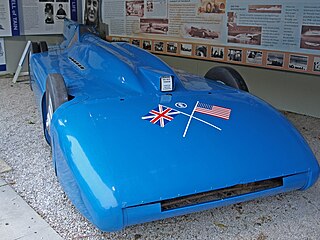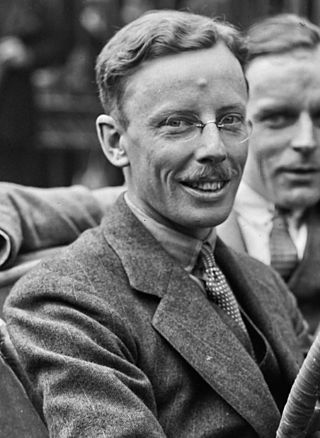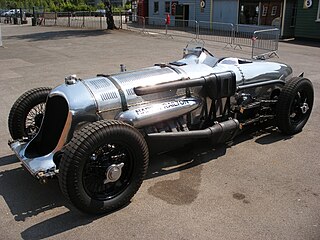Bentley Motors Limited is a British designer, manufacturer and marketer of luxury cars and SUVs. Headquartered in Crewe, England, the company was founded by W. O. Bentley (1888–1971) in 1919 in Cricklewood, North London, and became widely known for winning the 24 Hours of Le Mans in 1924, 1927, 1928, 1929 and 1930. Bentley has been a subsidiary of the Volkswagen Group since 1998 and consolidated under VW's premium brand arm Audi since 2022.

Walter Owen Bentley, (16 September 1888 – 13 August 1971 was an English engineer who founded Bentley in London. He was a motorcycle and car racer as a young man. After making a name for himself as a designer of aircraft and automobile engines, Bentley established his own firm in 1919. He built the firm into one of the world's premier luxury and performance auto manufacturers, and led the marque to multiple victories at the 24 Hours of Le Mans. After selling his namesake company to Rolls-Royce in 1931, he was employed as a designer for Lagonda, Aston Martin and Armstrong Siddeley.

Sydney Charles Houghton "Sammy" Davis was a British racing motorist, journalist, graphic artist and clubman.

Sir Henry Ralph Stanley Birkin, 3rd Baronet, known as Tim Birkin, was a British racing driver, one of the "Bentley Boys" of the 1920s.

The Bentley 4½ Litre is a British car based on a rolling chassis built by Bentley Motors. Walter Owen Bentley replaced the Bentley 3 Litre with a more powerful car by increasing its engine displacement to 4.4 litres. A racing variant was known as the Blower Bentley.

The Bentley 6½ Litre and the high-performance Bentley Speed Six were rolling chassis produced by Bentley from 1926 to 1930. The Speed Six, introduced in 1928, became the most successful racing Bentley. Two Bentley Speed Sixes became known as the Blue Train Bentleys after their owner Woolf Barnato raced the Blue Train in 1930.

The Bentley 3½ Litre was a luxury car produced by Bentley from 1933 to 1939. It was presented to the public in September 1933, shortly after the death of Henry Royce, and was the first new Bentley model following Rolls-Royce's acquisition of the Bentley brand in 1931.

Joel Woolf Barnato was a British financier and racing driver, one of the "Bentley Boys" of the 1920s. He achieved three consecutive wins out of three entries in the 24 Hours of Le Mans race.
Walter Thomas Frederick Hassan OBE, C.Eng., M.I. Mech.E. was a distinguished UK automotive engineer who took part in the design and development of three very successful engines: Jaguar XK, Coventry Climax and Jaguar V12, as well as the ERA racing car.
The 1930 24 Hours of Le Mans was the 8th Grand Prix of Endurance that took place at the Circuit de la Sarthe on 21 and 22 June 1930. It saw the first appearance of a German car and the first entry from female drivers.

The 1929 24 Hours of Le Mans was the 7th Grand Prix of Endurance that took place at the Circuit de la Sarthe on 15 and 16 June 1929.
The 1928 24 Hours of Le Mans was the 6th Grand Prix of Endurance that took place at the Circuit de la Sarthe on 16 and 17 June 1928.
The 1926 24 Hours of Le Mans was the 4th Grand Prix of Endurance, and took place on 12 and 13 June 1926. It was the first Le Mans race where the winner's average speed was over 100 km/h (62 mph), and also the first to break the 24-hour distance record set by Selwyn Edge at Brooklands in 1907.

John Francis Duff was a Canadian racing driver. He is best known for winning the 1924 24 Hours of Le Mans.
Ernest Arthur Douglas Eldridge was a British racing driver who broke the world land speed record in 1924. His was the last land speed record set on an open road.

The Campbell-Railton Blue Bird was Sir Malcolm Campbell's final land speed record car.

Bentley Blower No.1 is a racing car developed from the Bentley 4½ Litre by Sir Henry "Tim" Birkin to win the Le Mans twenty-four-hour race. The car was developed into its current form for racing at Brooklands.

Colonel Reginald Clive Gallop was an engineer, racing driver and First World War pilot. He was one of the team which developed their first engine for Bentley Motors.

An aero-engined car is an automobile powered by an engine designed for aircraft use. Most such cars have been built for racing, and many have attempted to set world land speed records. While the practice of fitting cars with aircraft engines predates World War I by a few years, it was most popular in the interwar period between the world wars when military-surplus aircraft engines were readily available and used to power numerous high-performance racing cars. Initially powered by piston aircraft engines, a number of post-World War II aero-engined cars have been powered by aviation turbine and jet engines instead. Piston-engined, turbine-engined, and jet-engined cars have all set world land speed records. There have also been some non-racing automotive applications for aircraft engines, including production vehicles such as the Tucker 48 and prototypes such as the Chrysler Turbine Car, Fiat Turbina, and General Motors Firebirds. In the late 20th century and into the 21st century, there has also been a revival of interest in piston-powered aero-engined racing cars.

The 1921 S.T.D. 'Works' Grand Prix chassis was built to the three-litre and minimum weight of 800 kilogrammes formula for that year's Indianapolis 500 and French Grand Prix de l’A.C.F. These team cars were modified by the Sunbeam Experimental department in Wolverhampton for the 1922 Isle of Man Tourist Trophy, which was won by one of the cars. A few months later, and with 1916 4.9-litre engines, two of the T.T. cars competed in the Coppa Florio, Sicily and gained second and fourth position.
















